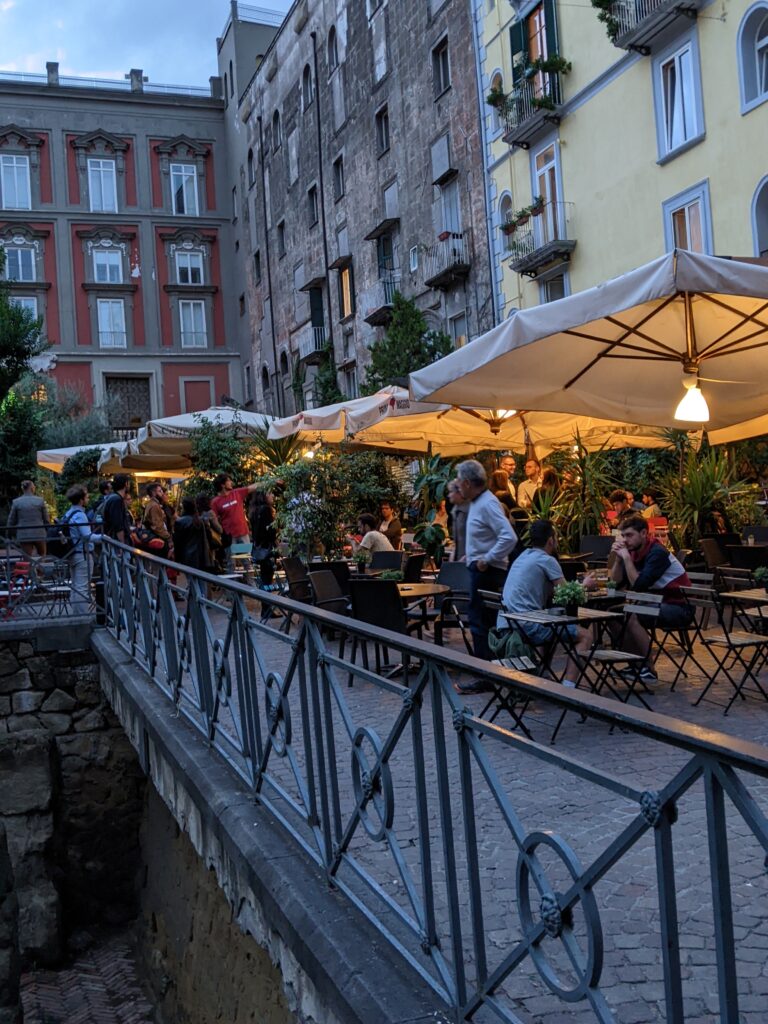
Naples is full of very beautiful if haughty young women with dusky complexions and Roman noses, and surly waiters who barely acknowledge your existence when you’re trying to place an order, and dog faeces smeared on old cobble stoned pavements, and laundry hanging from balconies in need of a coat of paint, and little wicker baskets dropped form high up apartments for shop keepers to fill, and operatic hand gestures, and people throwing back espressos at the bar and talking quickly and loudly.

The Neapolitan sassiness is fun, but from another angle it can also be very rude. Naples is also full of atmosphere, narrow laneways, and after dark very cool bars and cafes.
Naples also has MANN, possibly the best museum I have visited in my entire life, with the majesty and artistry of ancient Roman culture right in front of your nose. Below is the Farnese Hercules, a colossal statue that was found in the ancient Baths of Caracalla in Rome.

This is a huge figure – looking up at it is humbling.

Hercules symbolising strength in ancient Roman culture, this would have been a good inspiration to exercise in the gymnasium before a session in the hot or cold baths.

I was largely in Naples in order to visit Pompeii and Herculaneum – like many travellers.

Characters lounge on a triclinium and eat and drink and be merry. This fresco has been pulled off the wall at Pompeii and moved to MANN, as have the best and most beautiful of Pompeii’s art works.
Walking through the ruins of Pompeii that morning we had the entire ancient site to ourselves for the first hour of the day. Even for an hour after that there weren’t many people around. Then the hoards descended and it was over for atmosphere and serenity. But what a thrill to walk around the House of the Faun, and so many other famous Roman domus, alone, and take in the mosaic floors, the faded wall paintings in golds and reds, the white marble impluvium in the atrium, the peristyle surrounded gardens behind, and other architectural elements I had read of and seen in photos but never experienced in the flesh.

Bronze dancers found in one of the Roman houses in Pompeii… (Although now residing at MANN.)

The reader – Pompeii… Faded colours on the wall fresco all over the place reminds one of how this place was frozen in amber when the nearby volcano covered it in debris, killing those who had not fled and giving us a window into a wealthy Roman world in 79AD.

Peristyle gardens are a wonderful idea – the Greeks should really be thanked for inventing the stoa, but the Roman domus form feels good to walk around.

Vesuvius looming in the background above a peristyle garden in Pompeii.

I consider plunging my hands into the water when the space was was a bath house – at Herculaneum. Herculaneum is another Roman holiday town destroyed by the volcano two thousand years ago. If I’m honest it wasn’t as impressively extensive a site as Pompeii, but for someone like myself interested in ancient domestic architecture it was still intriguing. To lean on this basin in an ancient bath house for example, is a kind of somatic knowledge of a place and a long lost culture that only travel can bring. Photos and written communication are wonderful, but they are not enough.

A shallow impluvium at Herculaneum – water falls through a central hole in the ceiling of the large atrium and collects in this marble depressions. Water in domestic spaces in a Mediterranean climate is such a good idea.
Naples and Pompeii have Vesuvius looming over them, and just down the coast you find the elegance of seaside towns like Sorrento, high up on volcanic rock and graced by nineteenth century hotels. As you make your way to these places south of Naples, so photographed by tourists from around the world, you see striking economic inequality, with poverty in ugly concrete apartment blocks on one train stop, and 800 Euro a night hotels at the next (Sorrento). Tourists usually don’t photograph the poverty around the corner from their Amalfi coast clichéd and overpriced idea of a seaside idyll. And yet the physical beauty of the coastline south of Naples is entirely undeniable (if crowded).
